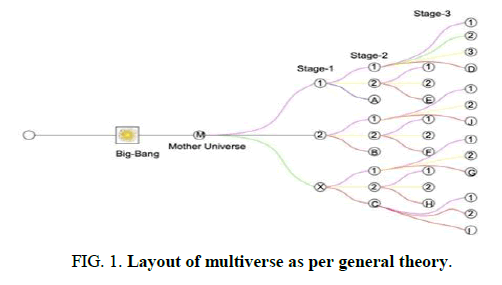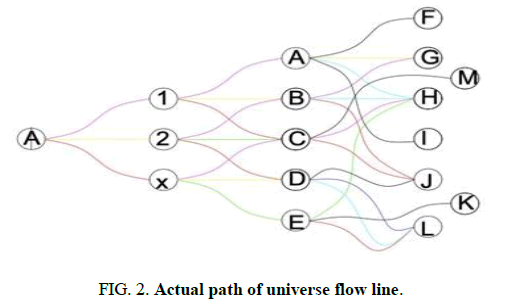Image Article
, Volume: 13( 11) DOI: 10.37532/2319-9822.22.11.001Integral of Multiverse in an Extreme Identical Condition
- *Correspondence:
- Sudip Sasmal
Department of Aeronautics, Birla Institute of Science and Technology, Palani, Rajasthan, India
Tel: 9609602761
E-mail: sudipksasmal@gmail.com
Received: December 02, 2022, Manuscript No. TSSE-22-82034; Editor assigned: December 05, 2022, PreQC No. TSSE-22-82034 (PQ); Reviewed: December 19, 2022, QC No. TSSE-22-82034; Revised: February 21, 2023, Manuscript No. TSSE-22-82034 (R); Published: February 28, 2023, DOI. 10.37532/2319-9822.2023.12(2).258
Citation: Sasmal S, Mondal S. Integral of Multiverse in an Extreme Identical Condition. J Space Explor. 2023;12(2):258.
Abstract
What is born, will die, the universal truth. Is that also true for another universe too or for the total multiverse system?
According to Mr. Hugh Everett the universe is splitting every moment from its beginning during every individual incident and increasing its number continuously. This is the theory how they are born but what about their end? Will they only split and increase the number of parallel universes for ever and ever or the whole things are happening in some other pattern?
Within this topic, we try to figure out the way how universes are behaves and interacts with each other.
Keywords
Multiverse system; Universe; Pattern; Interact; Individual incident
Introduction
From the theory of multiverse, we get to know that during every individual incident mother universe split into two or more parallel sister universe with verity of every possible result of the incident and in the next event sister universe turns into mother universe split again. This process continued up to the end of time. This theory shows that the number of universe continuously increases. But it questions about ‘the end of everything’ or how everything will end. In this paper the future of parallel universe and relations between them is discussed [1].
History and problem with the universes: According to Sir Hawkins, during every independent incident the universe split in every possible way with every possible result in it, where the multiverses are born.
Before Big-Bang as there is no universe, no time, any dimensions exist so no multiverse exists at that time. Then the Big-Bang happens and mother universe formed and then as time passes universe splits and splits and multiple universe born. And the number of universe increased time by time. This states that the number of parallel universes increasing in every moment in an organized chain reaction pattern (Figure 1).
Scientists predict the end of universe by disappearing of atom by converting to energy at last stage and returns to ‘before Big-Bang state’ again [2].
Analysis
But there a question arises, it is the end of this universe, there are still a very higher number of universes presents in the same timeline. So, the state is not actually ‘before Big-Bang’ state. Then what will happen with these universes. Some will surely parallelly end with our universe, but the question is about others [3].
But Figure 1 questioned about the ‘end of everything’. As per this the number of parallel universes will never decrease. So ‘the end of everything’ will never happen. But according to universal rule what will formed, will end. So, in actual the number of parallel universes cannot increase eternally. There should be some other way how this thing is happening, where the formula brakes.
In actual when two or more sister parallel universe formed from a mother universe, it separates on a specific dimension embedded on same space time. The difference along the dimension axis, increases or decreases depends on the events happening on the respective universe [4].
How much the variance between the universe increases it cause in increase in the axial distance along the dimension between them. And decreases in variance cause decrease their axial distance along the dimension [5].
And even if the variance between two or more sister universe decreases, which are from different mother universes, then also their axial distance decrease, which result these universes come across each other.
In that condition when the variance between them will be zero, both will be exactly identic in such case the axil distance between them along the dimension will be zero and both universe will fall across each other and marge to a single universe and this merged universe will follow the time path further (Figure 2).
According to the above properties if any two or more random universe become exactly identical, they will merge to a single universe and that merged universe will follow the further time path [6].
And the merging of the random universe will not happen suddenly, it happens gradually, as their variance become decreases, they will be more identic and the axial distance between them along the dimension will be decreasing and the universes will come across gradually. And finally, when they become exactly identic, their axial distance become zero and they will fall across each other and merge to a single universe (Figure 3).
And this theory states if we could find any way to jump between the universes, It will require more effort or energy to jump to a universe which have more variance than to a universe which have less variance.
Conclusion
Analyzing the above thesis, we can say that universes are splitting and at the same time they also merging. Splitting result increase their quantity by forming two or more copy of actual mother universe with the different effect of different possible result.
At the same time merging decreasing their actual quantity by merging two or more identical universe to only one universe. It also states that, if travel from one universe to another will possible, then the required energy will depend on the states of both the universes. If variance between them is more, it will take more energy/effort and if variance is less, it will require less energy/effort.
References
- Hawking SW. Gravitational radiation in an expanding universe. J Math Phys. 1968;9(4):598-604.
- McMahon JM, Morales MA, Pierleoni C, et al. The properties of hydrogen and helium under extreme conditions. Rev Mod Phys. 2012;84(4):1607.
- Caldeira AO, Leggett AJ. Path integral approach to quantum Brownian motion. Phys A: Stat Mech Appl. 1983;121(3):587-616.
- Knödlseder J, Von Ballmoos P, Frontera F, et al. GRI: Focusing on the evolving violent universe. Exp Astron. 2009;23:121-138.
- Davis M, Efstathiou G, Frenk CS, et al. The evolution of large scale structure in a universe dominated by cold dark matter. Astrophys J. 1985;292(2):371-394.
- Steinhardt PJ, Turok N. Cosmic evolution in a cyclic universe. Phys Rev D. 2002;65(12):126003.



